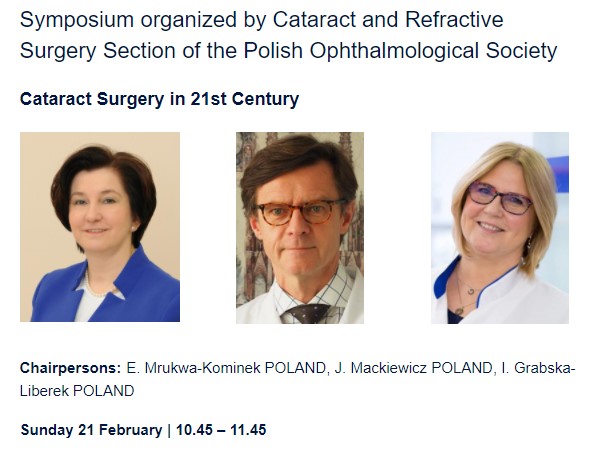Cataract surgery in the 21st century
Cataract surgery continues to benefit from ongoing innovation and progress in technology and techniques

Dermot McGrath
Published: Sunday, February 21, 2021
 Cataract surgery continues to benefit from ongoing innovation and progress in technology and techniques, according to expert speakers at the symposium Cataract Surgery in the 21st Century, organized by Cataract and Refractive Surgery Section of the Polish Ophthalmological Society.
Chaired by Drs Ewa Mrukwa-Kominek, Jerzy Mackiewicz, and Iwona Grabska-Liberek, the session gave delegates a broad overview of some of the key developments in modern cataract surgery practice.
Jacek Szaflik MD opened the session with a presentation on the benefits of femtosecond laser-assisted cataract surgery. He cited reduced corneal oedema, less trauma, reduced endothelial cell loss and better IOL power prediction and centration as key advantages of the technique compared to traditional phacoemulsification methods.
Wojciech Lubiński MD gave a comprehensive introduction to extended depth of focus (EDOF) IOLs in cataract surgery and the benefits they offer to patients. Ewa Mrukwa-Kominek MD focused her presentation on recent innovations in phacoemulsification machines, handpieces, and microscopes as well as the latest IOL designs in improving patient outcomes.
Surgical strategies to deal with the complex challenge of cataract surgery after iris and ciliary body tumour exoresection were the focus of the presentation by Bozena Romanowska-Dixon MD. She noted that implantation of a capsular tension ring and artificial lens implant after cataract surgery in patients with iris and/or ciliary body deficiency appears to be safe.
The indications and techniques involved in secondary IOL implantation were discussed by Iwona Grabska-Liberek MD, while the symposium concluded with a presentation by Bartlomiej Kaluzny MD on low and high extremes of corneal astigmatism correction with toric IOL implantation.
END
Cataract surgery continues to benefit from ongoing innovation and progress in technology and techniques, according to expert speakers at the symposium Cataract Surgery in the 21st Century, organized by Cataract and Refractive Surgery Section of the Polish Ophthalmological Society.
Chaired by Drs Ewa Mrukwa-Kominek, Jerzy Mackiewicz, and Iwona Grabska-Liberek, the session gave delegates a broad overview of some of the key developments in modern cataract surgery practice.
Jacek Szaflik MD opened the session with a presentation on the benefits of femtosecond laser-assisted cataract surgery. He cited reduced corneal oedema, less trauma, reduced endothelial cell loss and better IOL power prediction and centration as key advantages of the technique compared to traditional phacoemulsification methods.
Wojciech Lubiński MD gave a comprehensive introduction to extended depth of focus (EDOF) IOLs in cataract surgery and the benefits they offer to patients. Ewa Mrukwa-Kominek MD focused her presentation on recent innovations in phacoemulsification machines, handpieces, and microscopes as well as the latest IOL designs in improving patient outcomes.
Surgical strategies to deal with the complex challenge of cataract surgery after iris and ciliary body tumour exoresection were the focus of the presentation by Bozena Romanowska-Dixon MD. She noted that implantation of a capsular tension ring and artificial lens implant after cataract surgery in patients with iris and/or ciliary body deficiency appears to be safe.
The indications and techniques involved in secondary IOL implantation were discussed by Iwona Grabska-Liberek MD, while the symposium concluded with a presentation by Bartlomiej Kaluzny MD on low and high extremes of corneal astigmatism correction with toric IOL implantation.
END